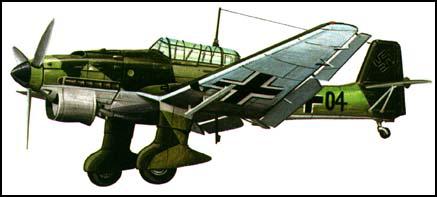Junkers Stuka
The Junkers Ju 87 dive bomber flew for the first time in 1938. It was given the name Stuka after the German word for dive bomber (Sturzkampfflugzeug). Designed by Hermann Pohlmann, it was powered by a Junkers Jumo engine. The aircraft had a maximum speed of 238 mph (383 km) and had a range of 490 miles (778 km). It was 36 ft 5 in (11.10 m) long with a wingspan of 45 ft 3 in (13.79 m). The aircraft was armed with 3 machine-guns and could carry 1,100 lb of bombs. Over 5,700 were delivered to the Luftwaffe before the end of the Second World War.

Primary Sources
(1) Douglas Bader wrote about the Junkers Ju 87 Stuka in his autobiography, Fight for the Sky (1974)
The Ju 87 (the Stuka), a single-engined dive-bomber, was probably the easiest enemy aircraft in the war to shoot down because it dived straight and pulled up straight. This was a requirement of its special type of bombing.
(2) German sergeant described the Ju 87 Stukas in action during the Western Offensive in May 1940.
Three, six, nine, oh, behind them still more, and further to the right, aircraft and still more aircraft, a quick look in the binoculars - Stukas! And what we are about to see during the next twenty minutes is one of the most powerful impressions of this war. Squadron upon squadron rise to a great height, break into line ahead and there, there the first machines hurtle perpendicularly down, followed by the second, third - ten, twelve aeroplanes are there. Simultaneously, like some bird of prey, they fall upon their victim and release their load of bombs on the target.
Each time the explosion is overwhelming, the noise deafening. Everything becomes blended together; along with the howling sirens of the Stukas in their dives, the bombs whistle and crack and burst. A huge blow of annihilation strikes the enemy, and still more squadrons arrive, rise to a great height, and then come down on the same target. We stand and watch what is happening as if hypnotized.
(3) Arthur Harris, Bomber Command (1947)
The Germans had won their victories in circumstances entirely different from any that we could contemplate for our own forces; they had used their air force against armies which had scarcely any air protection or air support and were very ill-provided with anti-aircraft guns, but this would not be the case if we encountered the German army in the future. Admittedly the specialised army co-operation types of aircraft might be rather more suitable on special occasions than the general-purpose bombers and fighters we were proposing to build, but they could not by themselves gain or maintain air superiority. The German dive-bombers were a case in point. They were no doubt accurate and alarming when used against undefended troops, but they were so easily shot down by efficient anti-aircraft fire, or, of course, by any normal fighter.
